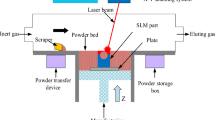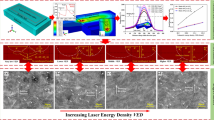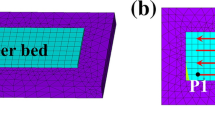Abstract
Selective laser melting/sintering (SLM/SLS) are the most established metallic powder bed additive manufacturing (AM) processes. Pre-heating of the powder and the part in SLM/SLS is performed in order to minimize residual stresses and increase the quality of manufactured parts. However, pre-heating constitutes a large portion, in some cases up to 40%, of the total energy consumed for building a part with SLM/SLS. This paper presents an energy consumption evaluation and comparison of the three existing pre-heating methods in SLM/SLS, which are (i) build chamber pre-heating, (ii) base-plate heating and (iii) laser pre-scanning heating. In order to calculate the energy consumption, transient thermal modeling with the finite element method is performed for all the three methods. The thermal model is applied in the case of the fabrication of a twin cantilever beam made out of titanium alloy Ti6AlV4. In addition, the initial energy required to heat the base plate and the process chamber up to the target temperature are calculated. Results show that laser pre-scanning heating leads to lower heat consumption when it comes to low volume parts, i.e., low part to powder bed volume ratio. For fabricating a higher number of parts or parts of high volume, i.e., high part to powder bed volume ratio, the chamber pre-heating and the base plate pre-heating method are found to be more efficient.
Similar content being viewed by others
References
Guo N, Leu M (2013) Additive manufacturing: technology, applications and research needs. Front Mech Eng 8:215–243. https://doi.org/10.1007/s11465-013-0248-8
European Commission (2014) Additive manufacturing in FP7 and horizon 2020. Brussels, Belgium
European Commission (2012) Analysis of options beyond 20% GHG emission reductions: member state results
Doris E, Cochran J, Vorum M (2009) Energy efficiency policy in the United States: overview of trends at different levels of government. Colorado, US
Doshi TK, Zahur NB (2013) Energy-efficiency policies in the Asia-Pacific: can we do better?, in: 2013 Pacific energy summit. Auckland, New Zealand
Mckane A, Price L, Berkeley L (2008) Policies for promoting industrial energy efficiency in developing countries and transition economies. Vienna, Austria
Salonitis K, Ball P (2013) Energy efficient manufacturing from machine tools to manufacturing systems. Procedia CIRP 7:634–639. https://doi.org/10.1016/j.procir.2013.06.045
Kempen K, Thijs L, Vrancken B, Van Humbeeck J, Kruth JP (2013) Producing crack-free, high density M2 Hss parts by selective laser melting: pre-heating the baseplate, in: Proceedings of the 24th international solid freeform fabrication symposium. Laboratory for Freeform Fabrication, Austin, TX, pp. 131–139
Risse J, Bremen S, Meiners W (2014) Development of aero engine component manufacturing using laser additive manufacturing outline processing of advanced alloys, in: dissemination workshop of MERLIN FP7 PROJECT. Ordizia, Spain
Sreenivasan R, Goel A, Bourell DL (2010) Sustainability issues in laser-based additive manufacturing. Phys Procedia 5:81–90. https://doi.org/10.1016/j.phpro.2010.08.124
Reinhardt T, Witt G (2012) Experimental analysis of the laser-sintering process from an energetic point of view. Ann. DAAAM 2012 Proc. 23rd Int. DAAAM Symp 23, 405–408
Baumers M, Tuck C, Bourell DL, Sreenivasan R, Hague R (2011) Sustainability of additive manufacturing: measuring the energy consumption of the laser sintering process. Proc Inst Mech Eng Part B J Eng Manuf 225:2228–2239. https://doi.org/10.1177/0954405411406044
Franco A, Lanzetta M, Romoli L (2010) Experimental analysis of selective laser sintering of polyamide powders: an energy perspective. J Clean Prod 18:1722–1730. https://doi.org/10.1016/j.jclepro.2010.07.018
Meteyer S, Xu X, Perry N, Zhao YF (2014) Energy and material flow analysis of binder-jetting additive manufacturing processes. Procedia CIRP 15:19–25. https://doi.org/10.1016/j.procir.2014.06.030
Morrow WR, Qi H, Kim I, Mazumder J, Skerlos SJ (2007) Environmental aspects of laser-based and conventional tool and die manufacturing. J Clean Prod 15:932–943. https://doi.org/10.1016/j.jclepro.2005.11.030
Paul R, Anand S (2012) Process energy analysis and optimization in selective laser sintering. J Manuf Syst 31:429–437. https://doi.org/10.1016/j.jmsy.2012.07.004
Verma A, Rai R (2013) Energy efficient modeling and optimization of additive manufacturing processes, in: Proceedings of the 24th international solid freeform fabrication symposium. Laboratory for Freeform Fabrication, Austin, TX, pp. 231–241
Strano G, Hao L, Everson RM, Evans KE (2011) Multi-objective optimization of selective laser sintering processes for surface quality and energy saving. Proc Inst Mech Eng Part B J Eng Manuf 225:1673–1682. https://doi.org/10.1177/0954405411402925
Xiong J, Zhang G, Qiu Z, Li Y (2013) Vision-sensing and bead width control of a single-bead multi-layer part: material and energy savings in GMAW-based rapid manufacturing. J Clean Prod 41:82–88. https://doi.org/10.1016/j.jclepro.2012.10.009
Mertens R, Vrancken B, Holmstock N, Kinds Y, Kruth J-P, Humbeeck JV (2016) Influence of powder bed preheating on microstructure and mechanical properties of H13 tool steel SLM parts. Phys Procedia 83:882–890. https://doi.org/10.1016/j.phpro.2016.08.092
Aggarangsi P, Beuth J (2006) Localized preheating approaches for reducing residual stress in additive manufacturing. In: Proceedings of SFF symposium, Austin, TX, pp.709–720. Austin, TX: The University of Texas at Austin
Kishore V, Ajinjeru C, Nycz A, Post B, Lindahl J, Kunc V, Duty C (2017) Infrared preheating to improve interlayer strength of big area additive manufacturing (BAAM) components. Addit Manuf 14:7–12. https://doi.org/10.1016/j.addma.2016.11.008
Kellens K, Renaldi R, Dewulf W, Kruth J, Duflou JR (2014) Environmental impact modeling of selective laser sintering processes. Rapid Prototyp J 20:459–470. https://doi.org/10.1108/RPJ-02-2013-0018
Khan M (2010) Selective laser melting ( SLM ) of gold ( Au ). Loughborough University
Hagedorn Y (2013) Towards finer structures: state of the art in selective laser melting (SLM), in: Precision fair 2013. Veldhoven, Netherlands
Papadakis L, Loizou A, Risse J, Bremen S, Schrage J (2014) A computational reduction model for appraising structural effects in selective laser melting manufacturing. Virtual Phys Prototyp 9:17–25. https://doi.org/10.1080/17452759.2013.868005
Renishaw additive manufacturing system AM250 User guide (2013) Stone, UK
Milberg J, Trautmann A (2009) Defect-free joining of zinc-coated steels by bifocal hybrid laser welding. Prod Eng 3:9–15. https://doi.org/10.1007/s11740-008-0140-2
Chen W, Molian P (2008) Dual-beam laser welding of ultra-thin AA 5052-H19 aluminum. Int J Adv Manuf Technol 39:889–897. https://doi.org/10.1007/s00170-007-1278-3
Arcam 2017. Ti6Al4V Titanium Alloy
Mills KC (2011) Recommended values of thermophysical properties for selected commercial alloys, 1st ed. Woodhead Publishing Limited https://doi.org/10.1016/B978-1-84569-990-1.50021-1
Fischer P, Romano V, Weber HP, Kolossov S (2004) Pulsed laser sintering of metallic powders. Thin Solid Films 453-454:139–144. https://doi.org/10.1016/j.tsf.2003.11.152
Tolochko NK, Arshinov MK, Gusarov AV, Titov VI, Laoui T, Froyen L (2003) Mechanisms of selective laser sintering and heat transfer in Ti powder. Rapid Prototyp J 9:314–326. https://doi.org/10.1108/13552540310502211
Bugeda G, Cervera M, Lombera G (1999) Numerical prediction of temperature and density distributions in selective laser sintering processes. Rapid Prototyp J 5:21–26. https://doi.org/10.1108/13552549910251846
Wang E, Nelson T, Rauch R, Gmbh C (2004) Back to elements—tetrahedra vs. hexahedra, in: 2004 International ANSYS Conference. ANSYS, Inc., Pittsburgh, PA
Roberts IA (2012) Investigation of residual stresses in the laser melting of metal powders in additive layer. University of Wolverhampton
Fan Z, Liou F (2012) Numerical modeling of the additive manufacturing (AM) processes of titanium alloy. In: Nurul Amin AKM (ed) Titanium alloys—towards achieving enhanced properties for diversified applications. InTech, Rijeka, pp 3–29. https://doi.org/10.5772/34848
Author information
Authors and Affiliations
Corresponding author
Rights and permissions
About this article
Cite this article
Papadakis, L., Chantzis, D. & Salonitis, K. On the energy efficiency of pre-heating methods in SLM/SLS processes. Int J Adv Manuf Technol 95, 1325–1338 (2018). https://doi.org/10.1007/s00170-017-1287-9
Received:
Accepted:
Published:
Issue Date:
DOI: https://doi.org/10.1007/s00170-017-1287-9




